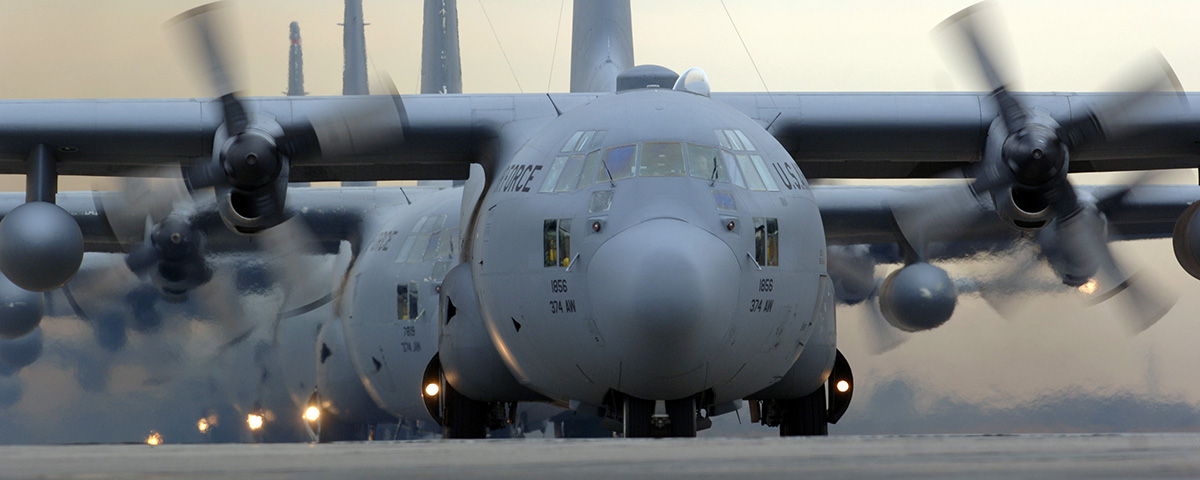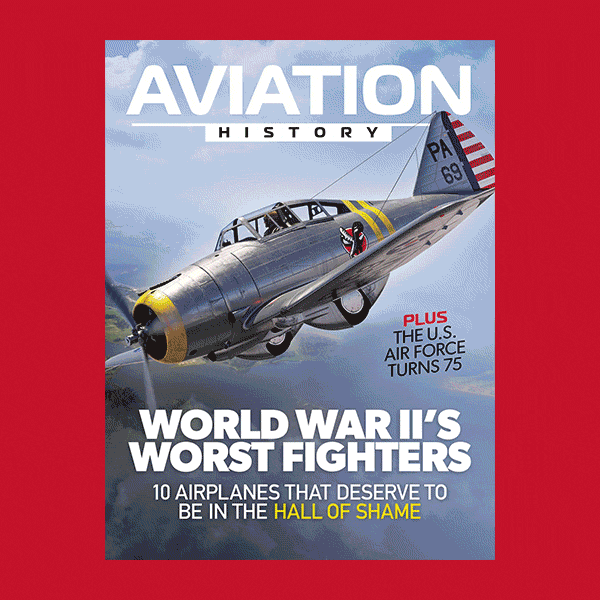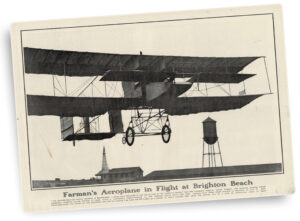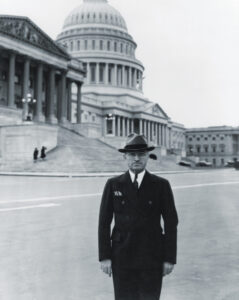Kelly Johnson made few mistakes as Lockheed’s star engineer, but he made a beaut when he offered his opinion of the original C-130. “Hibbard, if you sign that letter,” Johnson said, pointing to the cover sheet that was to accompany Lockheed’s C-130 prototype proposal to the U.S. Air Force, “you will destroy Lockheed.” He thought the Hercules, which had all the style and grace of a road grader, was so ugly that the company wouldn’t sell enough to recoup its considerable development expenses. Fortunately, his boss, Lockheed V.P. Hall Hibbard, overruled the Emperor of Burbank. Some said that Johnson hated the Herk because it couldn’t shoot, drop bombs or go supersonic. Nor did it help that it was only Lockheed’s second four-engine production airplane, and that the first, the Constellation, was one of the most beautiful aircraft ever to fly.
Johnson worshipped speed, sophistication and beauty. The Herk prayed at the altar of simplicity, reliability, ruggedness and economy. Yes, the C-130 in prototype form had a nose like a goat. Yes, the C-130 was a boxcar with wings on fat Tonka-toy wheels, and yes, it had a straight wing that looked like an ironing board bolted atop its fuselage. The airplane was totally out of character for a company that prized aesthetics. This was Lockheed, forgodsakes, not the Grumman Iron Works or Republic ThunderThud. The Lockheed of Connies, Shooting Stars and missile-with-a-man-in-it Starfighters. Get a grip!
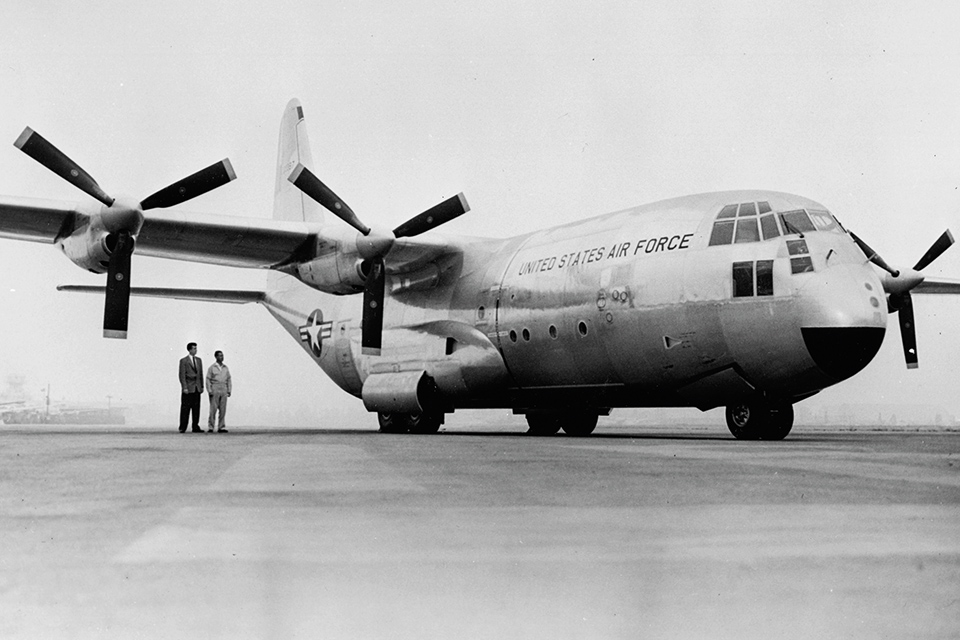
But Kelly Johnson disdaining the C-130 was like Enzo Ferrari poking fun at the Chrysler Minivan. The soccer mom truck was a vehicle whose time had come. So was the Herk. “The Hercules is a good design,” Johnson eventually admitted, “but there is no market for it. We’ll probably only sell about 100 of them.” As I write this, more than 2,400 C-130s of seven basic models and a total of 70 individual variants have been sold throughout the world.
While the 1950s Air Force sired badass jet fighters and mega-engine strategic bombers, the neglected orphan of its fleet was the transport, the cargo plane, what later came to be called the airlifter. As America went to war in Korea with Johnson’s F-80s and then swept-wing North American F-86s, supplies and troops were still being hauled in Ernie Gann–era Douglas C-47s, C-54s and some leftover Curtiss C-46s. The Fairchild C-119 Flying Boxcar was state of the art for tactical chores—airborne troopers called it the Dollar Nineteen and hoped to never have to ride in one—and the obese, double-deck Douglas C-124 Globemaster II was the strategic-airlift superplane. Yet they all relied on piston engines. Even the biggest recips didn’t have the power to carry truly significant tonnage, and since many transports were twins, they had a fatal flaw: If you lost an engine, particularly on takeoff, staying in the air when loaded was a desperate game. Even the four-engine C-124 could only gain 50 feet per minute on a warm day if it lost an engine on takeoff while loaded.
It took the Army six weeks to move two divisions from the U.S. to Korea by sea to fight the war. American airlifters didn’t have the necessary range, and they didn’t have the payload to carry heavy support equipment and armor.
A Pentagon committee was formed to fix this for the future, to give the Air Force a tactical transport with great payload and good range. (Tactical means an airplane that can go to the forward battle area; strategic transports, like today’s Lockheed C-5 and Boeing C-17, handle the intercontinental missions but are too valuable to risk in hot-fire zones.) A colonel on the committee, whose name seems to be lost to history, finally framed the need in understandable terms. “We need a medium transport,” he said,“that can land on unimproved ground, be extremely rugged, be primarily for freight transport with troop-carrying capability, and carry about 30,000 pounds for 1,500 miles.” He had defined the C-130, which would do this and more. Much more.
When the Air Force put numbers to the need, they came up with a requirement for what at the time seemed like a superplane: a 35,000- foot high-altitude cruise capability at 280 knots at one end of the spectrum, and a controllable 125 knots down low and slow for airdrops and STOL capability at the other. Plus the ability to carry 15 tons of cargo into dirt strips, with reliability and power that no piston engine could provide, and a range of 2,000-plus miles.
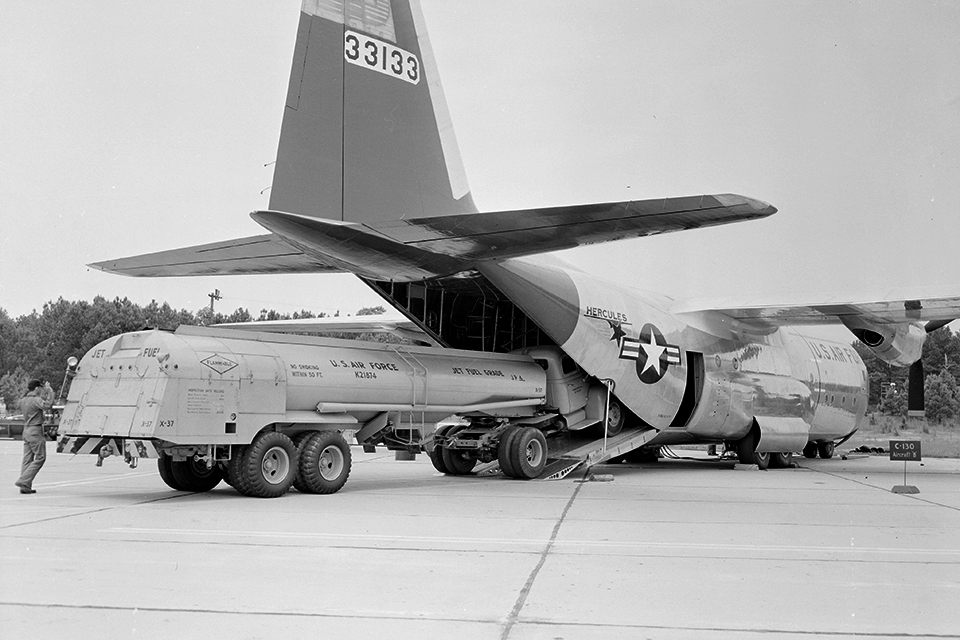
Everything about the aircraft that Lockheed came up with in answer to this request for proposal was designed to address those needs. The cargo area is boxcar-huge, rectangular and unobstructed (no spar carry-throughs or sidewall bulges) and it sits belly-to-the-ground at truck-bed height, so that the C-130 has true ro-ro capability: roll-on/roll-off loading.
The C-130’s most distinctive feature is a schnoz as multifaceted as a disco ball, with 23 individual windowpanes, some of them below and others behind the flight crew. It is configured to allow pilots to see everything around them in an unfamiliar, unprepared landing zone that might even require using prop reverse to back up, and with no marshallers waving wands for guidance. The lowest windows are for use during airdrops, so the pilots can keep the drop zone in sight even after it has passed under the nose.
The Herk’s vertical tail is enormous and mounted up high—enormous to provide slow-speed stability and control, high to leave an unobstructed area under it for trucks and cargo just aft of the loading ramp. The landing gear is squat and simple, retracting into fuselage pods that take no space from the cargo area and allow for the most basic straight-up, straight-down retraction mechanism—no fancy linkages or complex gear-folding geometry. The tires are fat and low-pressure, the aeronautical equivalent of off-roaders. They are mounted in tandem pairs, one behind the other on each side, so that the front tire flattens and compacts soft ground while its partner behind it rolls easily through the hardened rut that it creates. And the gear’s track— the distance between the wheel pairs—is narrow enough to permit the C-130 to use a highway as a runway.
Inside the right-hand gear pod is a strong, strident turbine APU (auxiliary power unit) that can be fired up to provide full electrical power for ground operation, including air conditioning, which is important for an airplane designed to not only carry cargo into a combat area but to ferry casualties out. More important, the C-130’s APU can start the engines when the nearest ground power cart is 150 miles away. Large airplanes—transports, World War II bombers— have had small gasoline-powered ground power units that could provide a bit of electricity since the days of 1930s flying boats, but the C-130’s APU is only the second powerful turbine unit to be mounted in an airplane (the C-124’s was the first).
It’s sometimes forgotten that the C-130 was the very first U.S. airplane, other than fighters and bombers, to use turbine engines. And it was the first U.S. production turboprop plane of any kind. (Early Hercules pilots got used to tower controllers telling them their engines were trailing smoke and appeared to be on fire.) The fact that the Allison division of General Motors was developing a powerful lightweight turboprop engine, the T56, was a stroke of luck for Lockheed—one of the few examples of a totally new airframe design that could be mated with a new power plant that was largely ready, willing and able.
Turboprop engines come in two basic flavors: free turbine and single shaft. In a free-turbine engine—the ubiquitous PT6 being the best example—a gas-generator turbine blows its super-hot exhaust through a second turbine, and that turbine turns the prop. The only connection between the two turbines is hot air.
A single-shaft turboprop like the T56 has a gas-generator turbine connected by a solid shaft directly to a reduction gearbox that drives the propeller. A T56’s gas generator (the “jet engine” part) spins at a constant speed—just under 14,000 rpm. It is shafted to a transmission, which spins its propeller at a constant speed, a very efficient flop-flop-flop 1,020 rpm. Advancing the “throttle” on a T56—more accurately called a power lever—has no effect on the engine’s or prop’s speed. It simply changes the pitch of the propeller blades. As the prop takes a more aggressive bite of air, that causes more fuel to be fed to the gas generator, hence more power. Firewall the power levers for takeoff, and the constant-speed props go to torque-monster fine pitch and continually adjust their angle as airspeed increases or as different amounts of power are selected. From the moment a C-130 begins to taxi until it shuts down after landing, the distinctive hum of its engines stays constant, growing and shrinking only in volume.
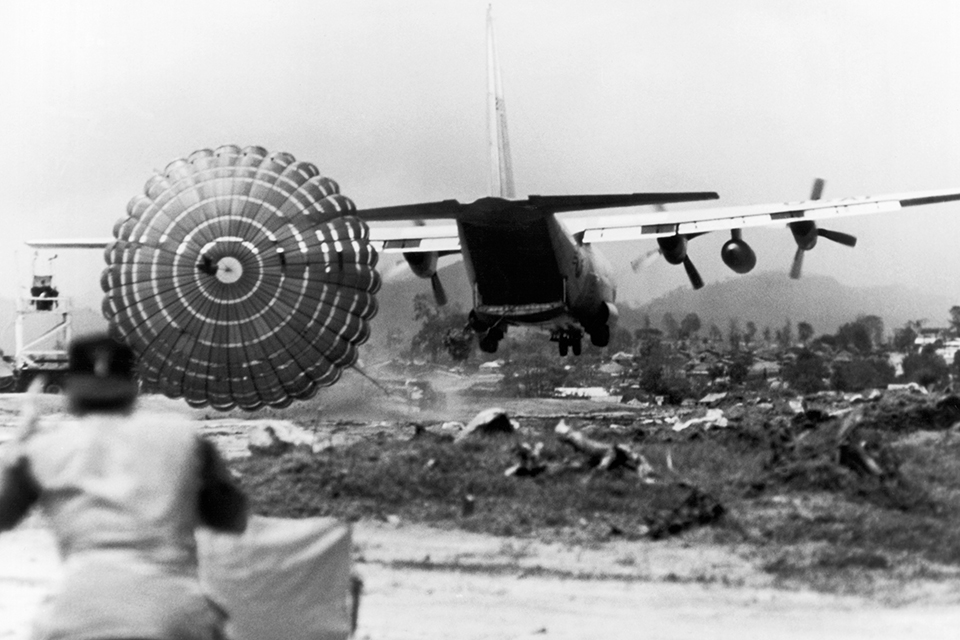
In a C-130, power comes on the instant it’s demanded by the pilot—no jet engine spool-up time, not even a piston engine’s brief lag. For Air Force transport pilots, few of whom had ever seen a turboprop, much less flown one, the Hercules was an E-ticket ride. Long the object of every fighter pilot’s contempt and even the bomber drivers’ condescension, the trash haulers suddenly had an airplane that out-accelerated anything else in the Air Force and that handled like a dogfighter, thanks to innovative (at the time) hydraulically boosted flight controls. No more cranking a yoke, waiting for the turn to start and then feeding in a carefully timed correction, like conning a big sailboat. The Herk answered the helm right away.
Initially, the Lockheed C-130/Allison T56 mating wasn’t an out-of-the-box match made in heaven. Since prop pitch adjustment did all the heavy lifting in terms of power changes, the mechanisms and controllers that commanded those props were crucial. The YC-130 prototypes used Curtiss-Wright electric props, and they were problematic. Electrically activated constant-speed propellers offer a certain simplicity, in that they are entirely independent of the engine and require no plumbing or engine mods to allow engine oil pressure to drive the prop blades into varying degrees of pitch, but choreographing all four propellers on a YC-130 to adjust themselves in absolute synchronicity proved impossible. One or another prop surged or hung back a bit, giving the airplane an unpredictable and frequent yawing motion.
The solution turned out to be hydraulic props driven by engine oil pressure, which worked perfectly from day one. They also helped to make the initial production C-130A the arrogant hot rod of the family. “The A is for go, the E is for show,” C-130 pilots would later say, comparing the rough-as-a-cob C-130A to the long-range, more sophisticated C-130E. With its raw power, four huge AeroProducts props and light weight, the C-130A was overpowered enough to make its pilots outright laugh on climbout.
Unfortunately, nobody could hear them. The As were loud. Their props, still three-blades, were more than 15 feet in diameter, which put the tips of the two inboard engines close to the fuselage and hammered that aluminum drum with constant pulses of air. The next model, the C-130B, segued to four-blade props that were 12 feet in diameter, which moved the tips away from the Herk’s hull. Since the shorter blades still revolved at the engine’s fixed 1,020 propshaft rpm, the tips were traveling more slowly, which also made them quieter.
With four 3,750-hp engines—soon to be uprated to 4,050 apiece—the C-130 was one of the most overpowered aircraft in the military inventory. It could literally fly on one engine. Early in the airplane’s career, a C-130A lost three engines in a thunderstorm over the Smoky Mountains after hail pounded shut their oil-cooler doors, but the Herk made it to Pope AFB, in North Carolina, on its sole remaining T56. Another C-130A lost three engines to fuel contamination over the Pacific with a 10,000-pound load and 25 military passengers, who hastily donned life jackets. They made it to Clark AFB, in the Philippines, and the fourth engine died just as they turned off the active.
The C-130 development program’s nadir—though it could have been tragically worse— came on an April day in 1955. The number-two prototype was aloft on that bumpy afternoon with spring thunderstorms in the Atlanta area. It was close to finishing its test schedule for the day with several high-speed passes down the Marietta runway for air speed calibration. After the first, a test engineer staggered up to the cockpit to tell pilot Leo Sullivan that he really needed to get on the ground before he got seriously airsick from the turbulence. Sullivan, who could have told him to suck it up and barf into a bag, instead was considerate enough to bring the YC-130 straight into the pattern and land.
As the airplane rolled out, a fuel line quick-disconnect in the no. 2 engine let go, and a stream of jet fuel hit the hot engine and erupted in a trail of fire. Minutes after the airplane stopped and everyone evacuated amid cascades of foam from airfield crash trucks, the left wing buckled as the main spar melted, nearly falling on Sullivan, who had just been under the wing to take a look at the damage. Had Sullivan ignored the engineer and persevered with his test schedule, everyone would have been killed and the prototype destroyed.
The C-130 is surprisingly aerobatic. The Navy’s Blue Angels are supported by a Marine Corps C-130T fondly known as Fat Albert, which usually opens the show with its own acro routine. No loops or rolls, but remember this is a 40-ton transport aircraft designed almost 60 years ago. Even so, during the Vietnam War a number of C-130s were reportedly forced into splitesses and barrel rolls to evade SAMs and even a few MiGs.
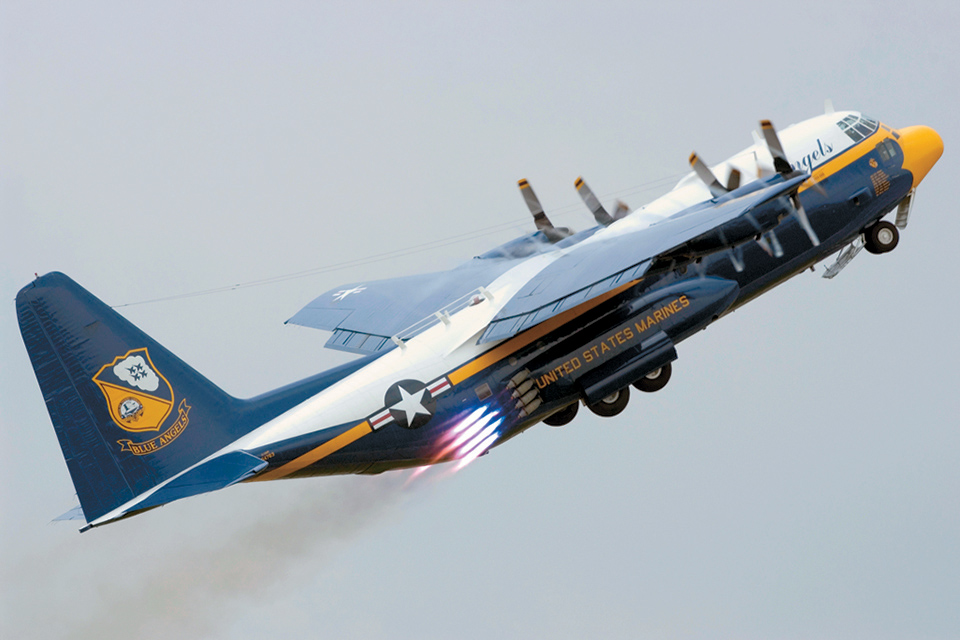
Early in the C-130’s career there was a four-ship Hercules aerial demonstration team called the Four Horsemen. The only team of four-engine airplanes in the world to ever perform what by FAA standards were aerobatic maneuvers, they did them in heart-stoppingly close proximity. Informally organized at first, they soon became an official Air Force demo team carrying the doctrine of C-130 maneuverability throughout the Military Airlift Command. The Horsemen were eventually disbanded because, rumor had it, they were beginning to steal a little of the spotlight from the Thunderbirds.
Airline pilots are still surprised when Center calls and says, “United 54, you have opposite-direction traffic, 12 o’clock and 2,000 feet above you, a C-130…” Seeing a straight-wing, prop-driven airplane at substantial flight levels can be a surprise, but depending on the load, some C-130s can cruise in the low 30,000s. In 1964 a lightly loaded C-130B climbed to 43,500 feet over the Parachute Test Range at El Centro, Calif., to drop a team of HALO (high altitude–low opening) jumpers. It would to this day be the world record for the C-130’s weight and power plant category, but the flight was not an official record attempt, it was just takin’ care of business. The official altitude record is held by the new C-130J: 36,560 feet, with a max-gross cargo load.
As was true of so many of the soldiers and Marines who flew aboard it and the crews that piloted it, the Herk came of age in Vietnam. That war was a rare and remarkable demonstration of how perfectly an aircraft could be conceived for missions that still lay in the future. Other military airplanes were “adapted” for Vietnam’s needs, some in ways their creators never intended, but all the C-130 needed was warpaint. It was said that if the Air Force’s and Navy’s F-4 Phantoms had been grounded, the Vietnam War would have continued, but if the C-130s had been grounded, we’d have had to throw up our hands and go home. The Herk was that important. It performed exactly the airlifts and airdrops for which it had been designed, plus a few that were made up on the spot. C-130s could disgorge great quantities of cargo and supplies on pallets, either by parachute from altitude or simply pulled out the back and dropped with the help of drag chutes at buzz job heights.
Inventive in-country load masters then developed a maneuver in which a Herk would land, do a 180 on the runway after rollout and accelerate into an immediate gettin’-outa-Dodge takeoff. Simultaneous release of all the cargo pallet tiedowns let the acceleration spit them out the rear ramp, and load masters judged the accuracy of their timing by whether the pallets landed on the runway, forklift-ready, with the same 2-inch between pallet spacing that they’d had while sitting in the cargo compartment.
The C-130 is the largest airplane ever to routinely use unprepared landing sites, meaning anything not made of concrete or asphalt. Certainly larger airplanes such as the C-5 and C-17 have landed on rough strips during acceptance testing to prove that it could be done if necessary, but turbofan jet engines don’t like dirt and debris. An off airport landing in a C-5 or C-17 requires immediate cleaning, maintenance and, usually, repairs. It is never done in the real world.
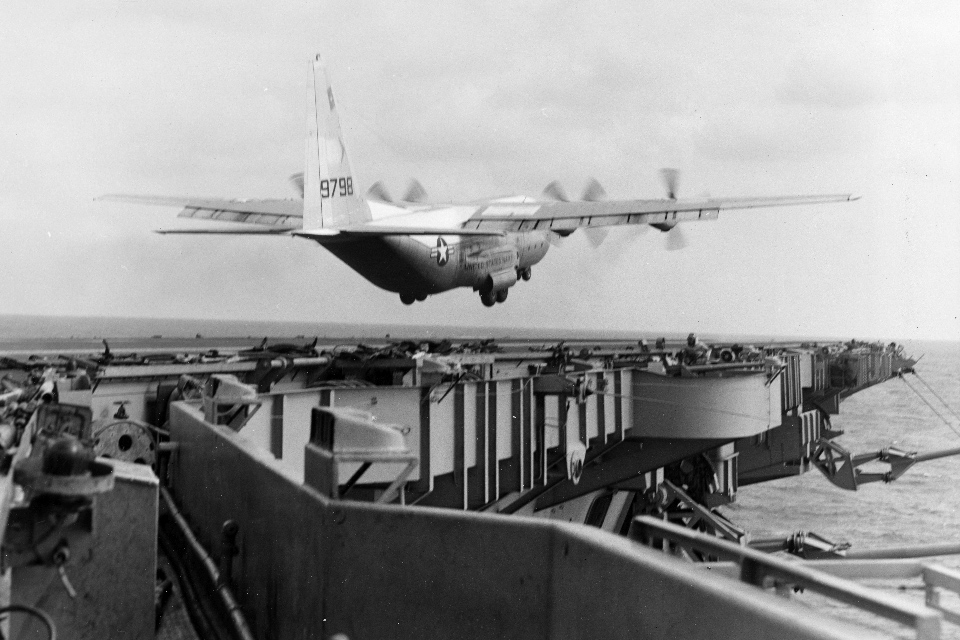
The Herk is also the largest and heaviest airplane ever to land and take off, unassisted—no arresting wire or catapult—from an aircraft carrier. In 1963 the Navy briefly considered using C-130s to replace its twin-engine Grumman COD (carrier onboard delivery) C-1s, which had limited range and payload, so they gave carrier pilot Lieutenant James Flatley a quick four-engine checkout and had him do 29 touch-and-goes and another 21 full-stop landings and takeoffs from USS Forrestal. Ultimately, the Navy decided that with a C-130 taking up space on a carrier’s deck, not much else could move until the Herk either departed or, in an emergency, was pushed over the side. The minimal clearance between the C-130’s right wingtip and the carrier’s island was also a bit too sporty for routine operations.
The most spectacular C-130 application in Vietnam was the AC-130 Spectre gunship—the first -130 not to be named Hercules. (The AC-130U gunship used in the 1991 Gulf War was called Spooky.) Depending on the variant, AC-130s have been equipped with a menu of armament that runs the gamut from 7.62mm mini-guns and 20mm and 40mm cannons to a 105mm howitzer.
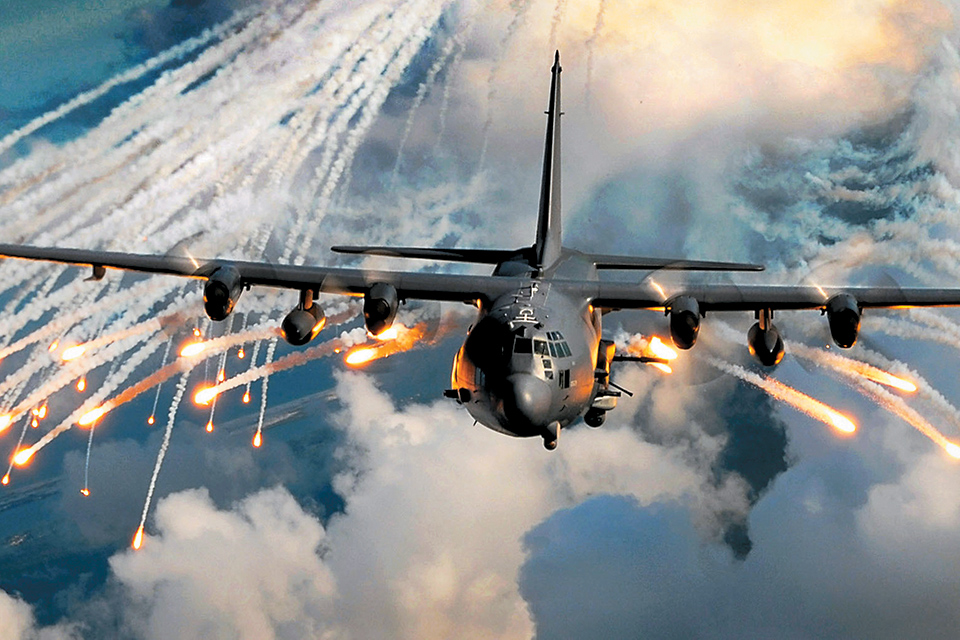
Some C-130s also flew as bombers, both in Vietnam and during the Gulf War. The Air Force had developed a 15,000-pound bomb with a 3-foot-long probe and fuze on its nose. The instant the probe touched the ground, the bomb delivered an immense, largely horizontal, above-ground blast that turned thick jungle into a nicely circular helicopter LZ. The BLU-82 bombs were too heavy to be carried by a B-52—not because of the sheer load but because the concentration of weight couldn’t be handled by a B-52’s weight-and-balance envelope—and the bombs were too thin-skinned to support underwing shackle hangers. So the daisy-cutter ordnance had to be loaded onto a pallet—which was ideal for rolling out the big aft door of a Herk.
Another C-130 record was set in Vietnam on April 19, 1975, the day a Vietnam Air Force Hercules carried a passenger load that would have challenged most widebody airliners: 452 passengers plus a crew of one, in an airplane normally configured for 92 passengers and a crew of five. (A VNAF C-130 instructor pilot flew the desperation mission solo.) The last fixed-wing flight out of Saigon, it was literally wall to wall with fleeing Vietnamese and American dependents, civilians and children. Thirty-two of them jammed onto the flight deck alone, and a second C-130 pilot aboard the flight couldn’t get through them to reach the copilot seat.
At the very end of the 20th century, Lockheed Martin introduced the C-130J Super Hercules, which currently is the only C-130 model in production. Its power plants—a Rolls-Royce version of an Allison doublespool engine (Rolls acquired Allison in 1995)—each put out 4,700 hp and drive lightweight, six-scimitar-blade, composite Rotol props, giving the C-130J almost 4,000 total hp more than the original C-130A. The J is far faster, quicker-climbing, higher-flying and longer-range than any of its predecessors, and it has set 54 world records in all of those categories and then some.
Here and there all over the world, half-century-old C-130s are quietly being retired, and someday 40 or 50 years in the future, it will happen to C-130Js as well. It is inevitable that we’ll then see something unprecedented: an airplane design that will have flown productively, in substantial numbers, for 100 years. Even the DC-3 won’t be able to make that claim.
The C-130 has been in production for 58 years, a world record for military aircraft of any kind. Perfectionists will point out that the Antonov An-2 biplane used by various air forces has been in production for 65 years, but the Ant is basically an unarmed civil design. The Beech Bonanza has also been in steady production for 65 years, but unlike the C-130 and the An-2, the current Bonanza has nothing but its name in common with the 1947 original.
It’s been said that the only replacement for a DC-3 is another DC-3, but it could also be said that a C-130 would fill the bill very nicely. Certainly the only replacement for a C-130 is another C-130. In 58 years, no airframer has been able to replicate the seemingly simple C-130’s qualities, though many have tried. Something has always been missing: pure utility, economy of operation, price, unprepared-field capability, maintenance simplicity, ruggedness… It may be that, as the head of Lockheed’s Advanced Design Department, Willis Hawkins, once said, “We got this one exactly right.”
For further reading, frequent contributor Stephan Wilkinson recommends: Herk: Hero of the Skies, by Joseph E. Dabney. Among the many YouTube videos featuring C-130s, three of our favorites are a jump-seater’s view of a performance by the Blue Angels’ Fat Albert (search “Fat Albert cockpit”), a newsreel showing the Forrestal carrier trials (search “C-130 landing on carrier”) and footage from the rocket-assisted STOL tests for Operation Credible Sport, a canceled second attempt to rescue the Iranian hostages in 1980 (search “Credible Sport”).

